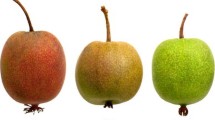Abstract
Zanthoxylum piperitum (prickly ash) was grown as a suspension culture in Schenk and Hildebrandt medium supplemented with 50 g sucrose l−1 and 0.5 mg 2,4-dichlorophenoxyacetic acid l−1 for 21 days with elicitation by pectin added at day 15. Volatile compounds were extracted from the culture and 3-hydroxy-2-butanone was identified by GC-MS as the most abundant compound, followed by γ-butyrolactone and 2,3-butanedione. 2,3-Butanedione, ethyl 3-methylbutyrate, and ethyl 2-methylpropanoate were identified as the most intense aroma-active compounds and represented the characteristic aroma of the culture.
Similar content being viewed by others
References
Chang JH, Shin JH, Chung IS, Lee HJ (1998) Improved menthol production from chitosan-elicited suspension culture of Mentha piperita. Biotechnol. Lett. 20: 1097-1099.
Collin HA (1988) Flavors. In: Constabel F, Vasil IK, eds. Cell Culture and Somatic Cell Genetics of Plants, Vol. 5. San Diego, CA: Academic Press, pp. 569-585.
Dönenburg H, Knorr D (1995) Strategies for the improvement of secondary metabolite production in plant cell cultures. Enzyme Microb. Technol. 17: 674-684.
Fenn PF, Durbin RD, Kuntz JE (1977) Synthesis of tryptophol and o-acetyltryptophol from tryptophan by Ceratocystis fagacearum. Phytochemistry 16: 899-901.
Gamborg OL, Miller RA, Ojima K (1968) Nutrient requirements of suspension cultures of soybean root cells. Exp. Cell Res. 50: 151-158.
Kim JH, Lee KS, Oh WT, Kim KR (1989) Flavor components of the fruit peel and leaf oil from Zanthoxylum piperitum DC. Korean J. Food Sci. Technol. 21: 562-568.
Kojima H, Kato A, Kubota K, Kobayashi A (1997) Aroma compounds in the leaves of Japanese pepper (Zanthoxylum piperitum DC) and their formation from glycosides. Biosci. Biotechnol. Biochem. 61: 491-494.
Lin ML, Staba EJ (1961) Peppermint and spearmint tissue cultures. I. Callus formation and submerged culture. Lloydia 24: 139-145.
Mills DR, Lee JM (1996) A simple, accurate method for determining wet and dry weight concentration of plant cell suspension cultures using microcentrifuge tubes. Plant Cell Rep. 15: 634-636.
Mistry BS, Reineccius T, Olson LK (1997) Gas chromatographyolfactometry for the determination of key odorants in foods. In: Marsili R, ed. Techniques for Analyzing Food Aroma. New York: Marcel Dekker, pp. 265-292.
Molimard P, Spinnler HE (1996) Compounds involved in the flavor of surface mold-ripened cheeses: origins and properties. J. Dairy Sci. 79: 169-184.
Murashige T, Skoog F (1962) A revised medium for rapid growth and bio-assays with tobacco tissue cultures. Physiol. Plant 15: 473-497.
Murashige T, Tucker DPH (1969) Growth factor requirements of citrus tissue culture. In: Chapman HD, ed. Proceedings of the 1st International Citrus Symposium, Vol. 3. University of California, Reverside: Reverside Publication, pp. 1155-1161.
Park IS, Kim DI (1993) Significance of fresh weight to dry cell weight ratio in plant cell suspension cultures. Biotechnol. Tech. 7: 627-630.
Sahai O (1994) Plant tissue culture. In: Gabelman A, ed. Bioprocess Production of Flavor, Fragrance, and Color Ingredients. New York: John Wiley & Sons, pp. 239-275.
Schenk RU, Hildebrandt AC (1972) Medium and techniques for induction and growth of monocotyledonous and dicotyledonous plant cell cultures. Can. J. Bot. 50: 199-204.
Schieberle P, Hofmann T (1997) Evaluation of the character impact odorants in fresh strawberry juice by quantitative measurements and sensory studies on model mixtures. J. Agric. Food Chem. 45: 227-232.
Song WS, Oh SD, Park EH, Yu SO (1991) In vitro propagation of Zanthoxylum piperitum DC. I. Somatic embryogenesis and plant regeneration. Korean J. Plant Tiss. Cult. 18: 17-25.
Speranza G, Corti S, Fontana G, Manitto P (1997) Conversion of meso-2,3-butanediol into 2-butanol by lactobacilli. Stereochemical and enzymatic aspects. J. Agric. Food Chem. 45: 3476-3480.
Van den Dool H, Kratz PD (1963) A generalisation of the retention index system including linear temperature programmed gas-liquid partition chromatography. J. Chromatogr. 11: 463-471.
Author information
Authors and Affiliations
Rights and permissions
About this article
Cite this article
Kim, T.H., Kim, T.H., Shin, J.H. et al. Characteristics of aroma-active compounds in the pectin-elicited suspension culture of Zanthoxylum piperitum (prickly ash). Biotechnology Letters 24, 551–556 (2002). https://doi.org/10.1023/A:1014812508441
Issue Date:
DOI: https://doi.org/10.1023/A:1014812508441




